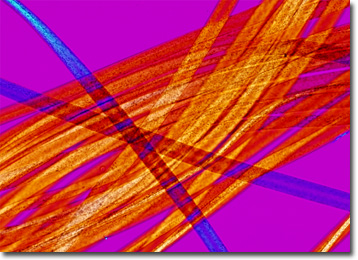Polarized Light Microscopy Digital Image Gallery
Orlon Fibers
Orlon is a trade name for a polyacrylonitrile fiber developed by the DuPont Company. The creation of the synthetic material in the 1940s was a byproduct of the company’s pioneering efforts in nylon and rayon.

Orlon was not initially well received by consumers who were not particularly impressed by the fiber when it was first sold in long single strands as a filament yarn. Yet, when it was reintroduced as Orlon staple, a bulky type of yarn consisting of short fibers, in the mid-1950s, it became a popular item in fabric stores. In fact, this new type of Orlon spawned a fashion craze, becoming the material of choice in women’s sweaters that were selling at impressive rates. By the next decade, the high demand for Orlon inspired DuPont scientists to develop even more varieties of the fiber, this time concentrating their efforts on meeting the needs of industrial manufacturers of items such as carpets and blankets.
Early in its development, Orlon was a problematic fiber to spin or dye. However, the ongoing work of DuPont eventually resulted in a material that was a tremendous commercial success, though it has been replaced in recent years by newer synthetic fibers in many applications. Warm and soft, Orlon was a longtime favorite in clothing and its resistance to degradation from sunlight and atmospheric gases also made it well-suited for outdoor items, such as beach umbrellas and awnings. Moreover, many items comprised of Orlon could be machine washed and dried, a distinct advantage over wool, a material that DuPont hoped the fiber would eventually supplant in the world market.
